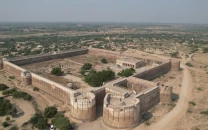Archaeological site unearthed after ‘heritage’ building is razed in Hyderabad
Experts claim remains found are from 18th century dynasties while Sindh govt claims it was built in 1960s

Remains of a structure from the 18th or 19th century with red-brick walls (right) were found during digging work at the demolished ‘heritage’ building (left) inside Pucca Qila, Hyderabad. PHOTOS: EXPRESS
The remains consist of around four-feet-wide walls made of small bricks. The portions of these several walls are scattered around the site. The walls surfaced during digging work at the site by Sindh Culture, Tourism and Antiquities Department that had planned to construct a new building for a museum.
However, after the discovery of the structure, the digging has been halted. "We have asked the department's experts to determine whether the walls were built during the Kalhoro or Talpur dynasties," the department's secretary, Akbar Laghari, told The Express Tribune.
The corroded walls of the harem are also of the same size and they are built with identical bricks as well. "We will consult experts from the department about how to make good use of this place," said Laghari when asked whether the department will abort the plan of constructing a new building for the planned museum.
He ruled out the possibility that old walls would be razed for the construction of the new building. "I think it [the underlying walls] is so strong that a new structure can be built over it." However, the secretary said the walls can also be preserved like parts of the fallen Berlin Wall in Germany. Laghari said the walls' study will not take long and his department's experts will be able to determine the nature of architecture in few days.

Controversial demolition
The Pucca Qila in Hyderabad, a fort built by a ruler of the Kalhora Dynasty, Mian Ghulam Shah Kalhoro in mid-18th century, is among the hapless archaeological sites in Sindh which have been allowed to decay. For several decades, apathy of the antiquities department and encroachment by tens of thousands of people has together contributed to the fort's degeneration.
The recent demolition of the building, which has been documented as the 'old offices of Mirs' in the book 'Inventory of Cultural Property in the Province of Sindh', edited by Yasmeen Lari and Michael Jensen, has aggravated the decadence. Many other experts also assert, unlike the department's secretary who says it was built in 1960s, that the building was part of the heritage.
"A complex of five spacious chambers is situated east of [the] harem. The halls were meant for offices of the Mirs and their treasury," states the book. Later during the British period, the building was used as the land record office and it was converted into a museum in the 1960s. The museum was looted and set on fire in 1987 during a riot involving some religious persons.
Both the harem and the building remained in possession of the Rangers and later police during the ethnic riots of late 1980s and 1990s. A police station was also later built in its premises. The book notes that the mosaic flooring was laid and the walls were whitewashed besides other renovation works by the people who occupied it.
The department's secretary, meanwhile, claimed that the building was constructed in the 1960s for the museum. "Let me clarify again it wasn't a heritage building," he emphasised pointing out that the demolition was approved and initiated in 2016. According to him, the structure remained idle since it was set ablaze around three decades ago.
"The officials who approved the demolition should be booked for this crime," said a former archaeology director Shahzore Tayabani while talking to The Express Tribune. According to Sindh Cultural Heritage Act, a person who destroys, damages, alters or defaces a heritage structure is punishable with up to three years imprisonment and Rs100,000 fine.
Exploration: DoAM awaits funds to resume survey of archeological sites
Tayabani, who has worked on Pucca Qila's preservation projects before his retirement in 2012, contended that the department's officials are lying about the demolished structure's status. "We always used to complain when archaeology department was under the federal government. But since the devolution, the Sindh government has been performing worse when it comes to preservation."
Another former director Qasim Ali Qasim deplored that the razed structure is located next to the department's regional office in Hyderabad and yet no one bothered to oppose the official move of razing it to the ground. "There were cellars in that building where Talpur rulers used to store their treasure owing to which it was also called the treasury building."
Qasim also demanded that the officers who approved the demolition should be identified and booked in the FIR. Naheed Zehra and Fateh Shaikh, both the serving directors of the department, said it was decided that a similar structure will be built in place of the razed one.
Published in The Express Tribune, April 2nd, 2019.



















COMMENTS
Comments are moderated and generally will be posted if they are on-topic and not abusive.
For more information, please see our Comments FAQ